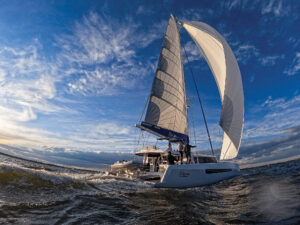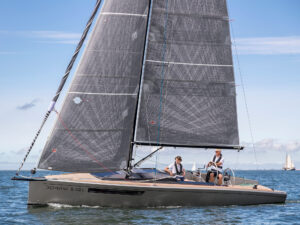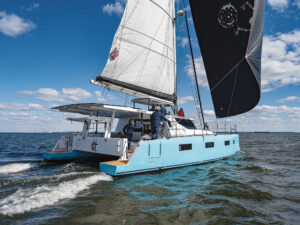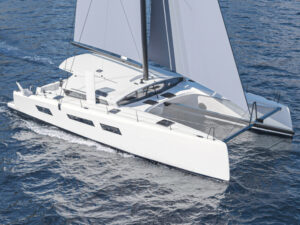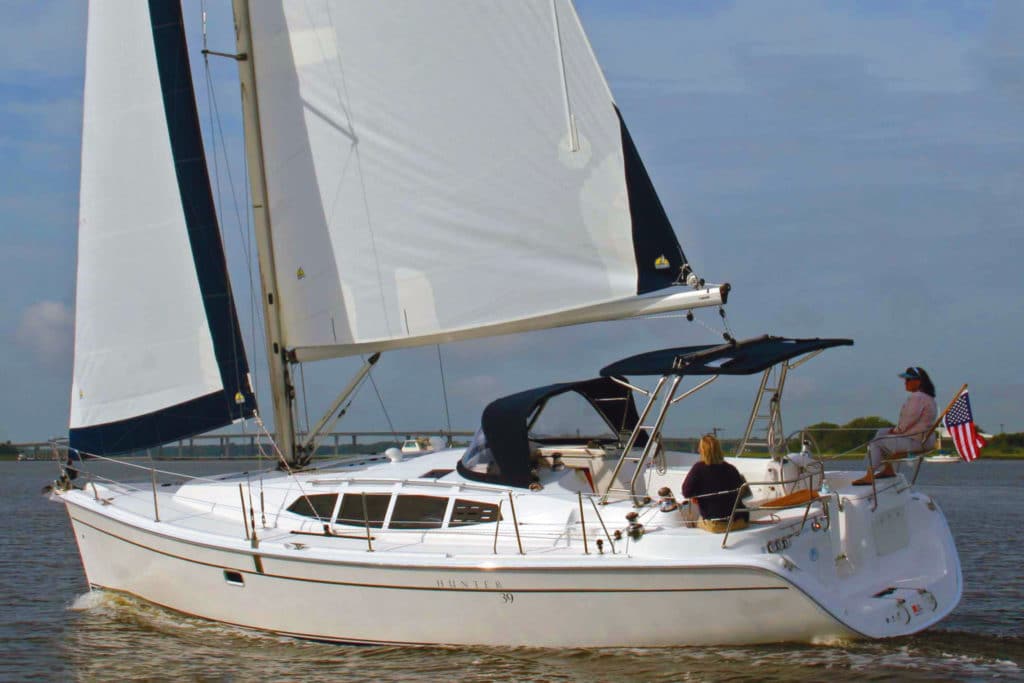
Boats measuring between 38 and 42 feet form a popular niche in the cruising market because they offer relative ease of handling while still being large enough to accommodate an entire family. Hunter Marine hopes to further widen that appeal with its new Hunter 39, a capable and comfortable cruising boat that can be “geared up” into a long-distance passagemaker.
In recent years, the company and its design team have been ambitious in their aims and innovative in their new models. While remaining competitively priced, they’ve constantly modernized their construction techniques, resulting in sound, European Union-certified (Category A, Ocean) hulls.
This is accomplished in three ways. The hull is hand-laid fiberglass and polyester resin in a female mold. A box-beam grid of the same shape is constructed separately. All the wiring conduits, plumbing, and interior furniture are built onto the grid, which is then lowered into the hull. A strong adhesive fuses the two into a single piece. Then the deck is popped from its mold and laid upon the hull. The two lips, or flanges, are joined with 5200 adhesive and fastened with stainless-steel bolts every 8 inches.
In the cockpit, wide seats encircle a large drop-leaf table. Access to the swim platform is excellent thanks to the wide opening created by the twin wheels. The bridgedeck rises 15 inches in front of the companionway and all but eliminates the threat of downflooding. The aft area of the cockpit is closed off by a hinged gate. The overall effect is a separate and secure area for lounging and an efficient area behind twin wheels in which to sail.
Hunter pioneered the B&R rig that eliminates the backstay. The obvious advantage is that the mainsail area can be increased with a roach. However, over 90 percent of Hunter’s recent customers have opted for the convenience of in-mast furling, which requires a hollow-cut leech that reduces sail area. The furling rig is 4 feet 5 inches taller than the conventional mast to provide more sail area for light-air performance. With either sail plan, the traveler controls, the double-ended mainsheet, and the headsail sheets are lead aft to the dual steering stations. Add the well-sized and properly placed winches with Hunter’s signature overhead-traveler arch and you have an efficient control center where the helmsman is never more than a flick away from blowing the sheets. The arch also provides a good mounting point for a bimini and doesn’t obstruct the deck flow forward.
Halyards and reefing lines are led under the deck to cabin-top winches that flank the companionway. There’s a lack of topside clutter, and flush deck hatches add to the clean lines.
Although there are lifeline gates to port and starboard, the boat is best boarded via the walk-though transom. The swim platform comes with a folding ladder and a shower.
I found the standard 22-pound anchor provided to be adequate, but I thought it should be beefed up with heavier ground tackle if extended cruising is in the plan. More tankage for fuel would also be appreciated by those going long distances.
The electric windlass on the boat we tested was recessed into the rode locker. While this does achieve a cleaner foredeck, I found that it was mounted so close to the well wall that it could be a challenge to operate the manual override if that became necessary. Hunter has since changed the standard windlass to rectify this situation.
Otherwise, there was plenty of room for the rode in the anchor well, and I was also pleased to see in there a well-positioned cleat designed specifically to take the load off the windlass.
The 39’s interior is entered through a secure companionway with good handholds and nonskid tread on the stairs. The cherry-stained wood panels and joinery is attractive and bright. The solid-wood floorboards-a new feature for Hunter with this model-are properly secured.
The modern L-shaped galley to starboard comes complete with stove, fridge, freezer, microwave, and Corian countertops. A pullout spice rack and stowage trays in the recesses of the cabin sole are nice touches that owners will appreciate.
The interior is offered in a two- or three-cabin configuration. In the two-cabin version, the owner’s aft cabin has an athwartship double berth with seats to either side and two hanging lockers. A second double berth forward is also flanked by a hanging locker and storage area. Of the two cabins, I found the natural lighting to be better forward and the forward cabin more appealing.
Sensibly, the 39 has only one head. A vanity area is separated from the head and shower by a stout acrylic panel.
A small but comfortable forward-facing nav station sits to port. A large saloon table with comfortable seating lies to starboard. The standard flat-screen television is mounted on the starboard bulkhead.
Out on the water, the boat tacked handily, even in the 8 to 10 knots of wind we experienced during our test sail on the Chesapeake. The near-plum stem extends the waterline length to 34 feet 8 inches, resulting in a moderate displacement-to-length ratio of 220 that indicates that the boat should be able to muscle through some chop.
And the sail area-to-displacement ratio of 19.4 suggests the boat will deliver a good turn of speed in stronger winds. Overall, it should prove weatherly, especially if fit with the deep keel.
At 3,200 rpm, we motored at a respectable 6.2 knots, and we topped out at 7.3 knots with 3,800 rpm. The decibel readings in the aft cabin and saloon fell within the acceptable range.
Due to the balanced spade rudder, the boat had a tight turning radius and backed well. It may be overbalanced, though, as it tended to overpower the Edson helms in a tight turn.
As with most dodger/bimini combinations, there’s a trade-off between shade and sail visibility. The solution, of course, is to install larger windows in the overhead canvas.
Overall, the Hunter 39 is modern in design and clean in execution, and given it’s price, it’s well worth a look for the owner who wants to take off with family or friends for a weekend, a vacation, or longer in comfort and safety.
Alvah Simon is a CW contributing editor and a frequent Boat of the Year judge.
Specs:
LOA 39′ 5″ (11.89 m.)
LWL 34′ 8″ (10.57 m.)
Beam 12′ 11″ (3.94 m.)
Draft (shoal/deep) 5′ 0″/6′ 6″ (1.52/1.98 m.)
Sail Area (100%) 763 sq. ft. (70 sq. m.)
Ballast 6,027 lb. (2,734 kg.)
Displacement 20,500 lb. (9,299 kg.)
Ballast/D .29
D/L 220
SA/D (furling) 19.4
Water 75 gal. (273 l.)
Fuel 36 gal. (136 l.)
Holding 25 gal. (95 l.)
Mast Height (furling)63′ 6″ (19.3 m.)
Engine 29-hp. Yanmar
Designer Glenn Henderson/
Hunter Design Team
Base Price $195,900
Hunter Marine
(386) 462-3630
www.huntermarine.com

